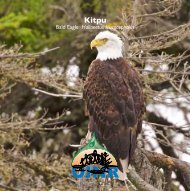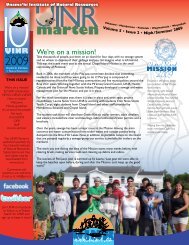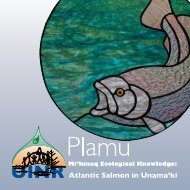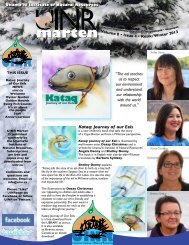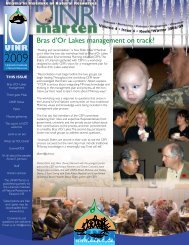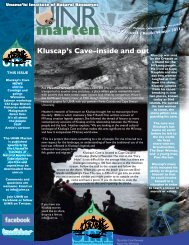Mi'kmaq Ecological Knowledge Distribution of Culturally Significant ...
Mi'kmaq Ecological Knowledge Distribution of Culturally Significant ...
Mi'kmaq Ecological Knowledge Distribution of Culturally Significant ...
Create successful ePaper yourself
Turn your PDF publications into a flip-book with our unique Google optimized e-Paper software.
ENVIRONMENTAL FACTORS<br />
Soil Drainage:<br />
Project partner, NewPage, provided the digital file CB_FEC_SOIL_TYPES.shp and<br />
supporting files. The digital (electronic) file contains geo-referenced polygons <strong>of</strong> all soil<br />
types found within Cape Breton Island, as well as features such slope, stoniness, and<br />
drainage characteristics similar to Agriculture Canada Soil Surveys <strong>of</strong> the 1960s. The Soil<br />
Drainage feature codes contained within the file range from R=Rapid to VP=Very Poor.<br />
This study required that the drainage feature codes be grouped into three assigned values<br />
<strong>of</strong> Good, Moderate, and Poor for Grey Tone mapping. The following are the groupings <strong>of</strong><br />
feature codes that were extracted and exported into individual new shape (.shp) files for<br />
Grey Tone mapping.<br />
Export_CB_FEC_SOIL_TYPES_DRAINAGE_GOOD.shp:<br />
Good (Dry): R= Rapid Drainage<br />
W= Well Drained<br />
Export_CB_FEC_SOIL_TYPES_DRAINAGE_MODERATE.shp:<br />
Moderate (Mesic-Moist): M= Moderate<br />
I= Imperfect<br />
Export_CB_FEC_SOIL_TYPES_DRAINAGE_POOR.shp:<br />
Poor (Damp-Wet): P= Poor<br />
VP= Very Poor<br />
Sub-Soil Drainage:<br />
The electronic file, CB_FEC_SOIL_TYPES.shp, contains large polygons where the soil<br />
type was listed as “Not Surveyed” and had no entry for the drainage characteristics. The<br />
geographic area not surveyed was mostly the Cape Breton Highlands and the Highlands<br />
north <strong>of</strong> Mabou, as well as Kelly’s Mountain, and Washabuck Centre.<br />
To determine drainage characteristics within these areas, provincial surficial geology data<br />
was used to infer overlying surface drainage characteristics based on the underlying parent<br />
material characteristics. Parent materials are the tills and deposited materials left behind<br />
after the last ice sheets melted. Some <strong>of</strong> these deposits were derived from slumping <strong>of</strong><br />
materials out <strong>of</strong> decaying ice. Some deposits were settled on the bottom <strong>of</strong> temporary<br />
glacial lakes and others were deposited by flowing glacier melt water. Over time, these<br />
surficial deposits developed thin layers <strong>of</strong> soil that shared the characteristics <strong>of</strong> the parent<br />
material. Coarse-textured parent material produced coarse-textured soils with good<br />
drainage, as fine-textured parent material produced fine-textured soils with generally poor<br />
drainage characteristics.<br />
The original, downloadable NS Provincial electronic file, p92003gs.shp, has “Unit” features<br />
such as “stoney till plain”, “Alluvial Deposit”, and “Silty Drumlin” as a few examples, and<br />
is supported by unit descriptions detailing the structural characteristics <strong>of</strong> the parent<br />
material deposits. Units <strong>of</strong> the original surficial geology file were selected based on<br />
structure characteristics, and exported into new individual shape (.shp) files <strong>of</strong> the inferred<br />
drainage characteristics <strong>of</strong> “Good” , “Moderate”, and “Poor” drainage.<br />
To avoid double counting with the Soil Drainage layer outside the areas “Not Surveyed”,<br />
a mask was created to block out Sub-Surface Drainage Grey Tone mapping information<br />
overlaying the areas that already have Soil Drainage Grey Tone mapping.<br />
7



